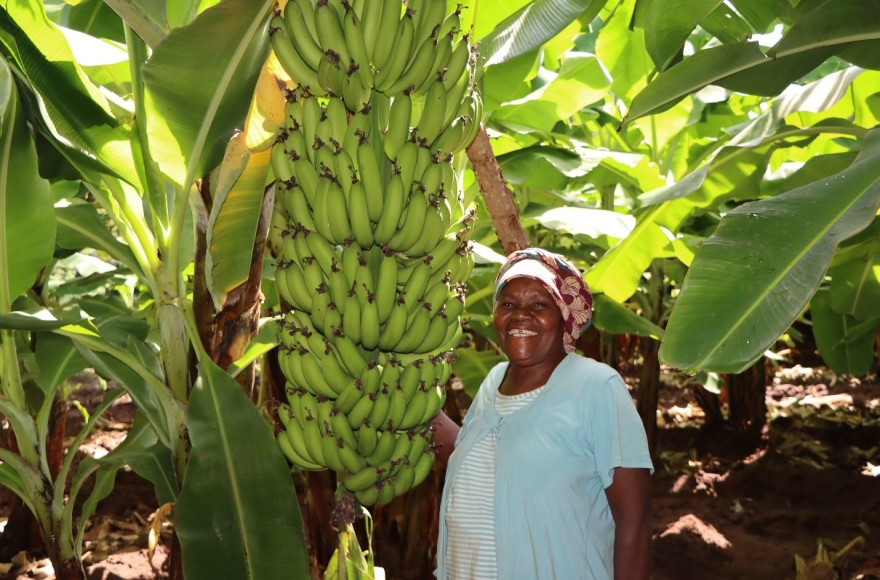About MESPT
- Micro Enterprises Support Programme Trust, Tausi Lane 01, Westlands
- Nairobi P.O Box 187 - 00606 Kenya
- +254 722 207905 / 735 333154
- info@mespt.org

The introduction of a credit-based model for accessing tissue culture (TC) banana seedlings under the Wanda-Maua Mazuri partnership has emerged as pivotal learning within the DMDP programme, significantly transforming banana production across the intervention area. This innovation has not only catalyzed seedling uptake but has also enhanced overall programme efficiency, aligning well with MESPT’s focus on inclusive green growth and sustainable agriculture.
Learning Identified through MESPT Intervention
The core learning derived from this initiative is the power of strategic partnerships and access to credit as enablers of smallholder participation in commercial agriculture. The DMDP programme is structured as a tripartite consortium comprising MESPT (with administrative oversight), ORANA (focusing on value addition and organic farming), and WAG (the produce offtaker). In 2024, WAG entered a partnership with Maua Mazuri (MM) to provide banana seedlings to farmers on credit. Under this arrangement, WAG mobilizes production groups, offtakes the mature bananas, and recovers the loan on behalf of Maua Mazuri, who guarantees a consistent supply of seedlings.
This model addressed one of the key constraints for banana farmers: the high upfront cost of tissue culture seedlings, which historically hindered uptake. The programme had identified through gross margin analysis that seedling costs constituted the largest input burden for farmers. Before the introduction of credit seedlings, uptake was sluggish, with monthly plantings averaging only 5,000 seedlings. However, following the rollout of the credit model, this figure jumped to 20,000 seedlings per month—demonstrating a fourfold increase and validating the intervention’s impact.
Another important learning is the use of structured production groups to enhance management and accountability. Each group comprises 10 farmers, each committing to plant at least 500 banana seedlings using the dense 2m x 2m spacing model. A lead farmer is appointed per group to coordinate seedling access, adherence to Good Agricultural Practices (GAP), and reporting. This structure improves traceability, peer accountability, and collective responsibility in production and loan repayment.
Documentation and contractual ownership have also been critical. Prior to seedling distribution, farmers are required to sign a growing contract and submit identification documents. This formalized approach has instilled a strong sense of ownership, reducing seedling loss and ensuring commitment to orchard management.
Context that Led to this Learning

Initially, the programme expected WAG, as an aggregator, to sustainably procure bananas from participating farmers. However, two years into implementation, volumes remained low, hampering WAG’s ability to meet market demand. This challenge triggered a need for innovative approaches, leading to the credit partnership with Maua Mazuri. Farmers were clustered into production groups to streamline seedling distribution, field management, and post-harvest offtake. The partnership has since proven highly effective in scaling production while addressing long-standing barriers in seedling access.
How learning has influenced delivery of DMDP/MESPT intervention
The introduction of credit seedlings has greatly enhanced the programme’s delivery efficiency. Previously, challenges such as low uptake due to cost, inefficiencies in offtake logistics, and poor credit access from microfinance institutions limited growth. This learning has addressed these barriers by offering a farmer-friendly financing model, creating a clear incentive to plant and manage banana orchards.
How the learning has enhanced programme result
The results have been substantial. In 2024 alone, the programme recorded 140,388 banana seedlings planted under the credit model, bringing the annual achievement to 202,351 seedlings and cumulative plantings to 326,953 seedlings since the beginning of the programme. These numbers underscore the catalytic effect of the credit seedlings model, which enabled the programme to surpass targets that would otherwise have remained unmet.
Potential opportunities to apply this learning into other areas of DMDP / MESPT intervention

There is high potential to replicate this model across other MESPT focus areas. For instance, youth and farmer groups could be supported to access credit seedlings in other counties, enhancing agricultural enterprise development. Already, partnerships are underway with the Taita Taveta County Department of Crops to integrate seedling distribution under the same model. The structure of production groups and use of lead farmers offers a replicable template for other crop value chains.
Opportunities to demonstrate this learning to sector stakeholders to influence action
This learning presents MESPT with a strategic opportunity to demonstrate effective models to other sector actors. Establishing partnerships with commercial input providers, financial institutions, and county governments could help scale the approach, promoting sustainable, market-driven agriculture. Moreover, the credit seedling model positions MESPT as a thought leader in innovative financing mechanisms for smallholder farmers. In conclusion, the Wanda-Maua Mazuri credit seedling model has emerged as a transformative approach that not only meets programme targets but also supports sustainable livelihoods and inclusive value chain growth. By leveraging partnerships, structured production systems, and formal documentation, MESPT has laid the foundation for a scalable, impactful solution to smallholder financing and production constraints.
Additional Comments (this includes testimonials)
“We’ve been trained on how to properly care for our banana orchards, which has helped minimize seedling losses. Thanks to the seedlings I received on credit, my harvest has improved significantly, and I now have a guaranteed market. From the training, I also learned to stop using suckers for planting, which has greatly enhanced the quality of my produce” – Florence Mzirai